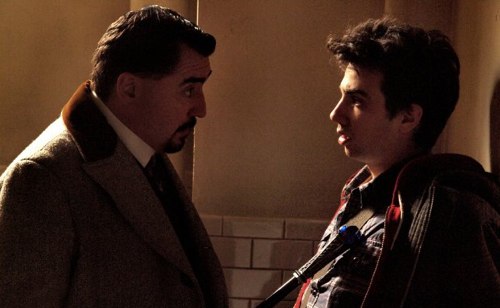To be a sorcerer, at least in the terms outlined in The Sorcerer's Apprentice, you've got to engage most of your brain, not the measly 10 percent most of us poor average Joes use. You also have to be able to harness electricity so you can mold fiery snowballs of energy with your hands and fling them at bad people. And pointy-toed leather shoes are not optional: Rubber-soled sneakers block the flow of energy. "Plus," as Nicolas Cage's sorcerer guru Balthazar tells his young student Dave (Jay Baruchel), "it helps to look classy."
It would take more than pointy-toed shoes to give The Sorcerer's Apprentice real class. The picture is fanciful in the most pedestrian way, a jumble of effects that are expensive-looking and yet, for the most part, conspicuously lacking in magic. The picture's saving grace is that much of it was shot in New York, and even though director Jon Turteltaub -- the guy behind the whoppingly successful National Treasure movies -- isn't so great on the follow-through, he does at least propose some intriguing and almost-magical ideas: For example, the way Balthazar appropriates one of the Chrysler Building gargoyles for use as his own private aircraft.
The problem is that you can see those gargoyles much better in The The's old "I Saw the Light" video, even though that, too was largely (though not all) illusion. The The Sorcerer's Apprentice gargoyles are murky-looking and half-glimpsed, an approach that would work well enough in a movie with an impressionistic, dreamy look. But The Sorcerer's Apprentice is too literal-minded in its vision; Turteltaub strives to show us realistic-looking magic, without realizing he'd be better off if he acknowledged that there's no such thing. Instead, we get human figures that emerge "magically" from swarms of cockroaches and sorceresses who dissolve into dust particles right before our eyes. It's the best CGI money can buy, and who cares?
Maybe the effects would feel more magical if the narrative structure holding them up were more stable. (The writers here include Lawrence Konner, Mark Rosenthal, Matt Lopez, Doug Miro, Carlo Bernard and the entire population of Belgium, though those last are uncredited.) The Sorcerer's Apprentice is set up with a backstory straight out of Sir Thomas Malory's Le Mort d'Arthur -- not. The great magician Merlin entrusts his secrets to three disciples, one of whom is a bad egg: There's Cage's Balthazar; his main squeeze the comely Veronica (Monica Bellucci, who doesn't get nearly enough screen time); and grumpy Horvath (a perpetually scowling Alfred Molina), who's in a bad mood because, among other reasons, he didn't get the girl.
Merlin's archenemy is the sorceress Morgana (Alice Krige), but after a magicians' scuffle she gets locked away in a Russian nesting-doll-type thingie called a grimhold. In fact, everybody except Balthazar gets locked away, and the dying Merlin hands him a craft-fair dragon ring and tells him to go out and find the Prime Merlinian, the only one who can save the universe from evil. Or something like that.
And that's all in the first 10 minutes. Cut to modern times -- 2000, specifically -- when a little kid on a school field trip wanders into a cavernous and dusty curio shop, meets a weirdo named Balthazar in a 19th-century distressed leather coat, accidentally frees Horvath from his little urn, and, apparently, has a nervous breakdown. Cut to 2010: That kid has grown up to be Baruchel's Dave, a nerdy NYU whiz-kid who builds Tesla coils in his spare time but also has his eye on a girl, Becky (Teresa Palmer), who used to be his childhood crush but is now all grown up.
Dave has written off the whole curio-shop incident -- which involved a sort of indoor lightning storm -- as a hallucination. Then Balthazar shows up and tells Dave that -- surprise! -- he's the Prime Merlinian and will have to trade his sneakers for pointy-toed leather shoes. And so forth.
The smallest surprise, in a movie that's almost wholly lacking in surprise, is that Cage is fun to watch. He may be an actor who makes a million dollars every time he blinks, but to his credit, even in a junky diversion like this one, he makes every blink count. Cage doesn't send up the goofy material; instead he approaches it with utter sincerity: There's muted, believable passion in his eyes even as he's serving up all that Prime Merlinian nonsense. I think plenty of us are frustrated with Cage because he takes so many roles that are beneath him. Then again, his saving grace as an actor may be that he doesn't act as if anything is beneath him.
Baruchel makes a suitably low-key counterpart to Cage; he keeps the awkward boy-genius routine going at a low, steady hum instead of cranking it up to deafening levels. In fact, he and Cage are just appealing enough to make you wish the movie around them were better. Scene after scene, Turteltaub, production designer Naomi Shohan and cinematographer Bojan Bozelli show us potentially magical ideas that just fall flat: A nod to the "Sorcerer's Apprentice" segment of Fantasia is charming at the beginning but goes on too long before winding down to a predictable end.
One of the movie's more inspired fillips is that Horvath has the ability to disguise his vehicle by turning all the cars on the street into taxi cabs. That's a stroke of genius worthy of someone like Terry Gilliam, but Turteltaub falls down on the execution: He shows us the sea of yellow cabs all right, but nothing about the moment sparkles. The idea floating behind The Sorcerer's Apprentice, and it's a marvelous one, is that in the city, magic is both everywhere you look and everywhere you don't look. Turteltaub shows us where to look by pointing, when the real magic is what's going on just outside our field of vision.
